Tirzepatide, a revolutionary medication for type 2 diabetes and weight loss, has become a widely discussed treatment option. Known for its dual-action targeting GLP-1 and GIP receptors, it regulates blood sugar levels and suppresses appetite, helping patients achieve transformative results. However, as with any medication, Tirzepatide can cause certain side effects, and one of the concerns often raised is increased thirst.
In this article, we’ll explore whether Tirzepatide can make you thirsty, the potential reasons behind this symptom, and how to manage it effectively.
What Is Tirzepatide and How Does It Work?
Tirzepatide works by mimicking the action of two hormones—GLP-1 and GIP—which regulate blood sugar, appetite, and metabolism. It has gained popularity for its ability to not only manage type 2 diabetes but also promote significant weight loss.
Key Benefits of Tirzepatide
- Blood Sugar Regulation: Enhances insulin sensitivity and reduces glucose production.
- Weight Loss: Clinical studies show users can lose up to 15-20% of their body weight.
- Cardiovascular Health: Improves cholesterol levels and lowers blood pressure.
Thinking about using Tirzepatide? Get started with a tirzepatide prescription by consulting licensed doctors online.
Does Tirzepatide Cause Increased Thirst?
Increased thirst is not a primary side effect of Tirzepatide, but it has been reported by some users. This symptom can occur due to various factors related to the medication’s effects on the body.
1. Blood Sugar Regulation and Thirst
Tirzepatide’s primary function is to lower blood sugar levels by improving insulin sensitivity and suppressing glucose production. While this is beneficial for diabetes management, fluctuations in blood sugar can lead to temporary changes in hydration levels, potentially causing thirst.
Why Blood Sugar Affects Thirst
- High blood sugar levels can lead to increased urination, causing dehydration and thirst.
- Rapid blood sugar regulation may initially disrupt the body’s fluid balance.
2. Appetite Suppression and Reduced Fluid Intake
Tirzepatide suppresses appetite, which may inadvertently lead to reduced food and water intake. If users don’t consciously hydrate, they may experience thirst as a result.
Impact of Reduced Caloric Intake
- Many foods, especially fruits and vegetables, contribute to daily hydration. Reduced food consumption can lower fluid intake.
- Dehydration may manifest as dry mouth or excessive thirst.
3. Rapid Weight Loss and Fluid Changes
One of Tirzepatide’s standout features is its ability to promote significant weight loss. However, rapid fat loss can alter fluid distribution and increase the body’s need for hydration.
How Weight Loss Affects Hydration
- The breakdown of fat cells releases stored water, potentially leading to temporary dehydration.
- Increased activity levels associated with weight loss can elevate hydration needs.
How to Manage Thirst While Taking Tirzepatide
If you experience increased thirst while using Tirzepatide, there are several steps you can take to manage this symptom effectively.
1. Stay Consistently Hydrated
Ensure you’re drinking enough water throughout the day to compensate for any fluid loss.
Tips for Staying Hydrated
- Aim for at least 8-10 glasses of water daily.
- Carry a reusable water bottle to encourage regular sips.
- Include water-rich foods like cucumbers, watermelon, and oranges in your diet.
2. Monitor Blood Sugar Levels
Regularly check your blood sugar levels, especially if you have diabetes, to ensure they remain within a healthy range. Sudden spikes or drops can contribute to dehydration.
Managing Blood Sugar
- Work with your healthcare provider to adjust your diet and medication as needed.
- Avoid skipping meals to prevent rapid changes in glucose levels.
3. Avoid Dehydrating Beverages
Certain drinks, such as those high in caffeine or sugar, can exacerbate dehydration. Limit your consumption of:
- Sugary sodas and energy drinks.
- Alcohol and caffeinated beverages like coffee or tea.
4. Adjust to Appetite Changes
Since Tirzepatide suppresses appetite, you may naturally eat and drink less. Make a conscious effort to include hydrating fluids even when you’re not feeling hungry or thirsty.
5. Consult Your Doctor
If thirst persists or worsens, consult your healthcare provider to rule out other underlying conditions, such as uncontrolled diabetes or kidney issues.
Need personalized advice? Get a tirzepatide online prescription and consult with experts today.
Other Side Effects of Tirzepatide
While increased thirst may occur for some users, it’s important to be aware of other potential side effects of Tirzepatide.
Common Side Effects
- Nausea and Vomiting: Often mild and temporary.
- Diarrhea or Constipation: Related to changes in digestion.
- Fatigue: Some users report feeling tired during the early stages of treatment.
Rare but Serious Side Effects
- Hypoglycemia: Particularly when combined with insulin or sulfonylureas.
- Pancreatitis: A rare but serious condition requiring immediate attention.
- Gallbladder Issues: Rapid weight loss can sometimes lead to gallstones.
Who Might Experience Increased Thirst on Tirzepatide?
Certain individuals may be more prone to experiencing thirst while taking Tirzepatide.
1. Diabetic Patients
Those managing type 2 diabetes may be more sensitive to fluctuations in blood sugar, which can lead to dehydration.
2. Individuals with High Activity Levels
If Tirzepatide promotes a more active lifestyle, increased physical activity can elevate hydration needs.
3. Rapid Weight-Loss Responders
Users who experience significant and rapid weight loss may require additional fluids to compensate for changes in hydration levels.
When to Seek Medical Advice
While mild thirst is usually not a cause for concern, certain symptoms warrant immediate medical attention:
- Excessive thirst accompanied by frequent urination.
- Persistent dry mouth despite drinking adequate fluids.
- Symptoms of dehydration, such as dizziness or dark-colored urine.
Conclusion
Tirzepatide may lead to increased thirst in some individuals, often as a result of blood sugar regulation, appetite suppression, or rapid weight loss. By staying hydrated, monitoring blood sugar levels, and making mindful dietary choices, you can manage this symptom effectively while enjoying the transformative benefits of Tirzepatide.
Take the first step toward better health by consulting licensed doctors for a tirzepatide prescription. With expert guidance, you can achieve your weight loss and diabetes management goals while addressing any side effects.
FAQs About Tirzepatide and Thirst
1. Does Tirzepatide make you thirsty?
Increased thirst is not a common side effect but can occur due to factors like blood sugar regulation, reduced fluid intake, or weight loss.
2. How can I manage thirst while taking Tirzepatide?
Drink plenty of water, include hydrating foods in your diet, and monitor blood sugar levels to prevent dehydration.
3. Should I be concerned about persistent thirst?
Persistent or excessive thirst may indicate underlying issues like uncontrolled diabetes or dehydration. Consult your doctor if this occurs.
4. Can weight loss from Tirzepatide cause thirst?
Yes, rapid weight loss can alter fluid balance and increase the body’s need for hydration.
5. How do I start Tirzepatide safely?
To begin, consult licensed doctors online for a tirzepatide online prescription and receive personalized advice tailored to your health needs.
















